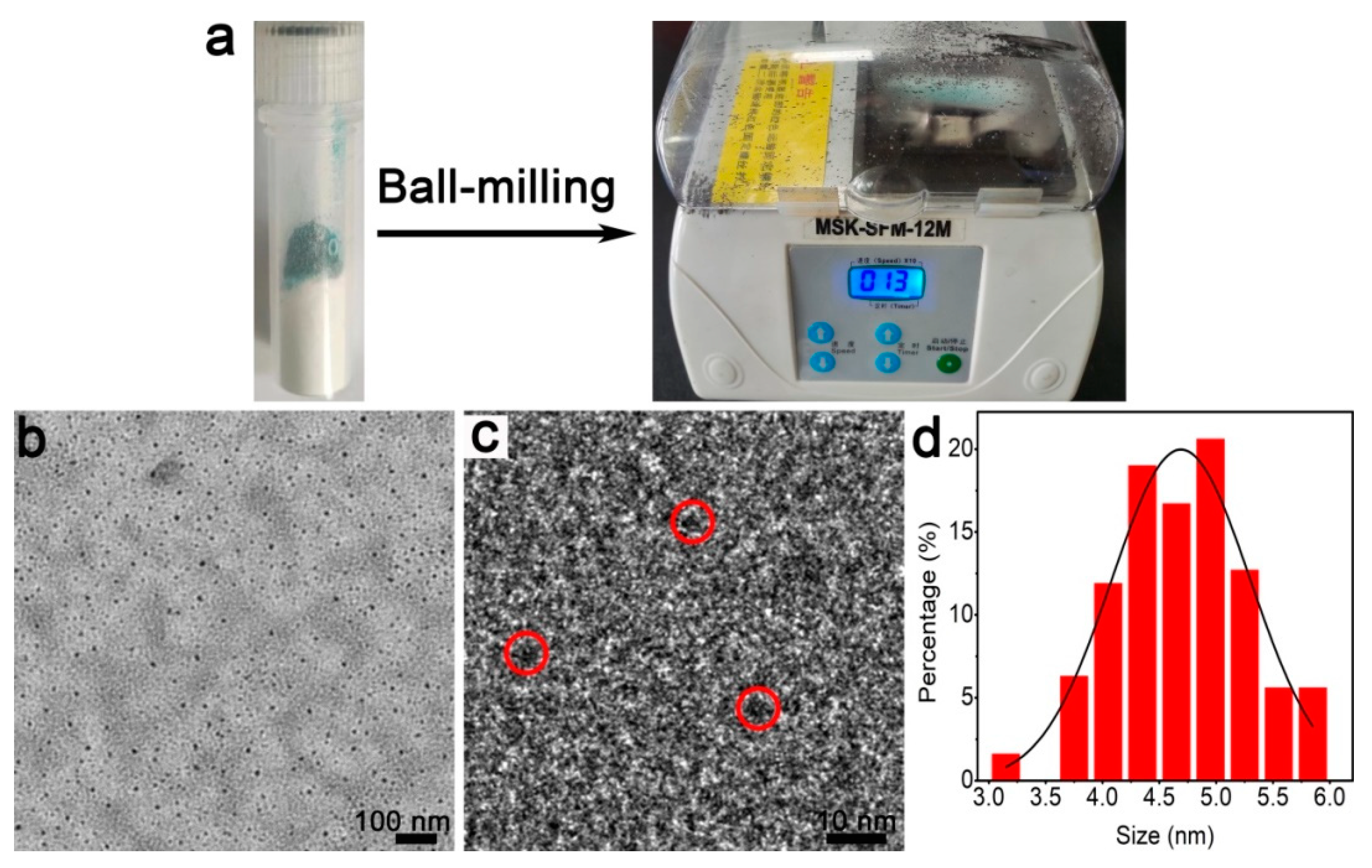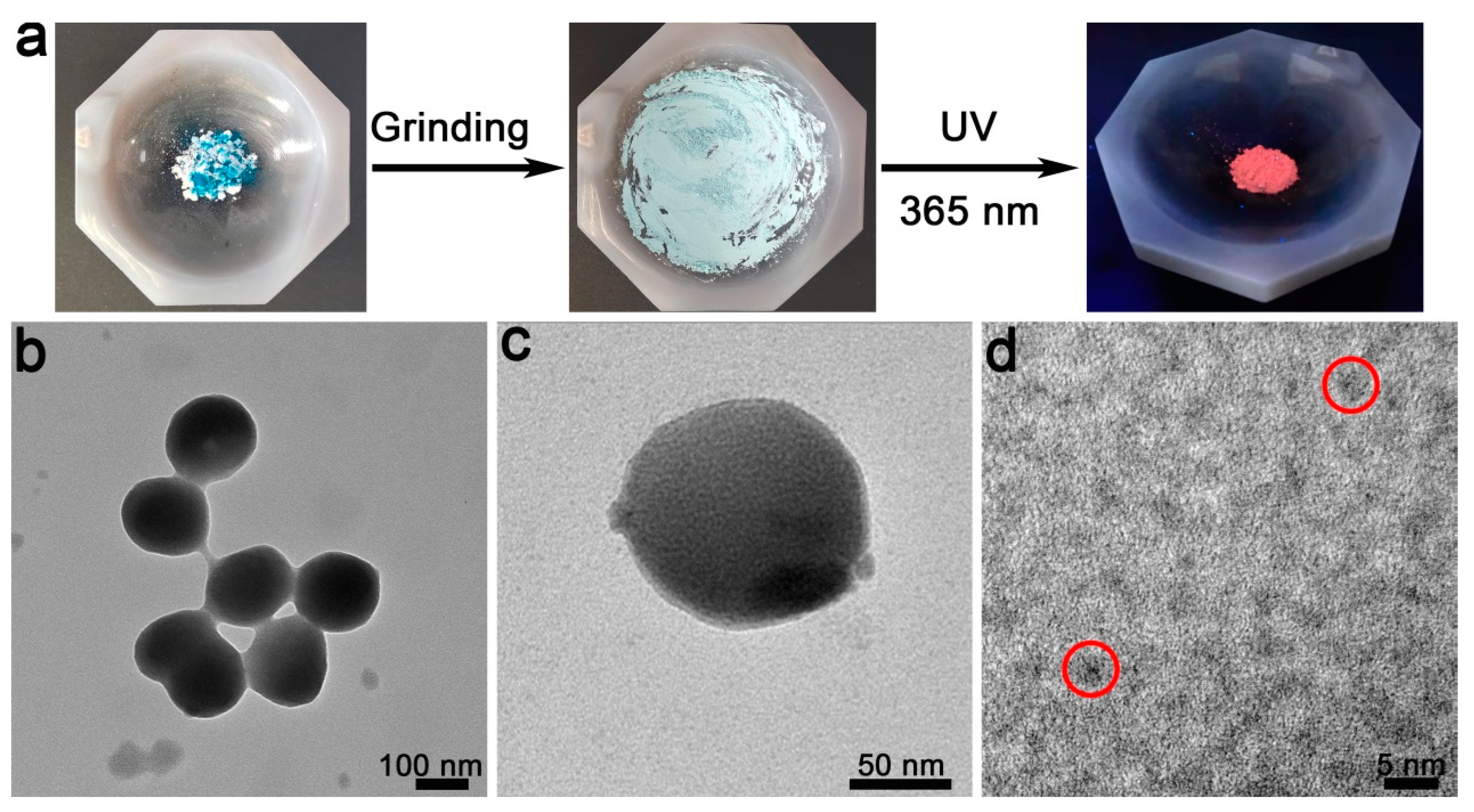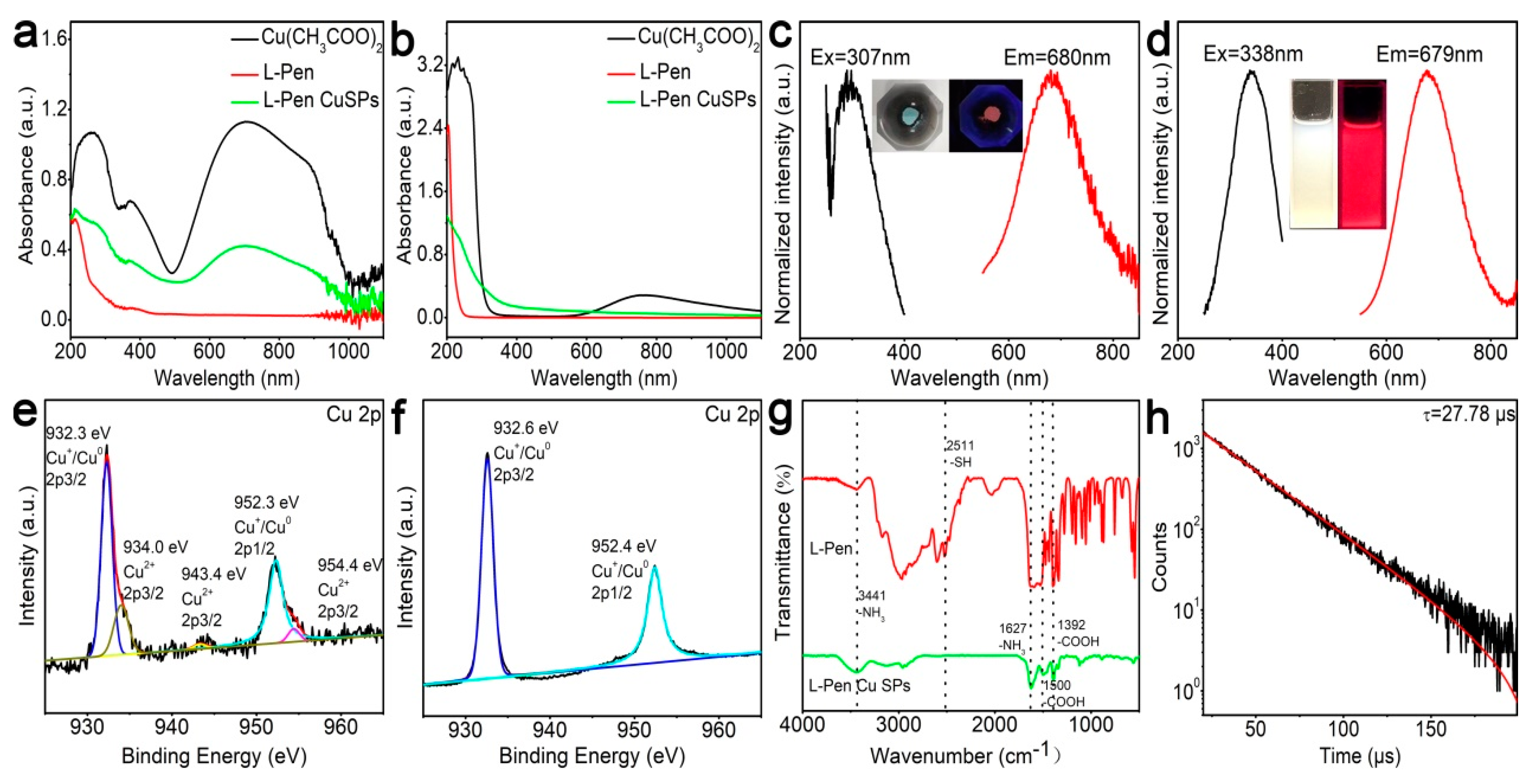Solid State Fabrication of Copper Nanoclusters and Supraparticles
Abstract
:1. Introduction
2. Experimental Section
2.1. Materials
2.2. Instruments
2.3. Fabrication Processes
2.3.1. Cu NCs Fabrication
2.3.2. CuSPs Fabrication
3. Results and Discussion
4. Conclusions
Supplementary Materials
Author Contributions
Funding
Data Availability Statement
Conflicts of Interest
References
- Zhou, S.; Peng, B.; Duan, Y.; Liu, K.; Ikkala, O.; Ras, R.H.A. Bright and Photostable Fluorescent Metal Nanocluster Supraparticles from Invert Emulsions. Angew. Chem. Int. Ed. 2022, 61, e202210808. [Google Scholar] [CrossRef] [PubMed]
- Ma, Z.; Gao, G.; Luo, Z.; Tang, X.; Sun, T. Tuning Chirality Transfer and Amplification of Supraparticles via Solvent Inducing Self-Aggregation of Chiral Gold Nanoclusters. J. Phys. Chem. C 2019, 123, 24973–24978. [Google Scholar] [CrossRef]
- Mortazavi Moghadam, F.; Bigdeli, M.; Tamayol, A.; Shin, S.R. TISS nanobiosensor for salivary cortisol measurement by aptamer Ag nanocluster SAIE supraparticle structure. Sens. Actuators B 2021, 344, 130160. [Google Scholar] [CrossRef]
- Jin, R.; Zeng, C.; Zhou, M.; Chen, Y. Atomically Precise Colloidal Metal Nanoclusters and Nanoparticles: Fundamentals and Opportunities. Chem. Rev. 2016, 116, 10346–10413. [Google Scholar] [CrossRef]
- Zou, X.; Jin, S.; Du, W.; Li, Y.; Li, P.; Wang, S.; Zhu, M. Multi-ligand-directed synthesis of chiral silver nanoclusters. Nanoscale 2017, 9, 16800–16805. [Google Scholar] [CrossRef]
- Zheng, Y.; Wu, J.; Jiang, H.; Wang, X. Gold nanoclusters for theranostic applications. Coord. Chem. Rev. 2021, 431, 213689. [Google Scholar] [CrossRef]
- Shang, L.; Dong, S.; Nienhaus, G.U. Ultra-small fluorescent metal nanoclusters: Synthesis and biological applications. Nano Today 2011, 6, 401–418. [Google Scholar] [CrossRef]
- Liu, Q.; Liu, Q.; Chen, Y.; Li, Y.; Su, H.; Liu, Q.; Li, G. Ir nanoclusters confined within hollow MIL-101 (Fe) for selective hydrogenation of α, β-unsaturated aldehyde. Chin. Chem. Lett. 2022, 33, 374–377. [Google Scholar] [CrossRef]
- Zou, J.; Fei, W.; Qiao, Y.; Yang, Y.; He, Z.; Feng, L.; Li, M.-B.; Wu, Z. Combined synthesis of interconvertible Au11Cd and Au26Cd5 for photocatalytic oxidations involving singlet oxygen. Chin. Chem. Lett. 2023, 34, 107660. [Google Scholar] [CrossRef]
- Lai, W.F.; Wong, W.T.; Rogach, A.L. Development of Copper Nanoclusters for In Vitro and In Vivo Theranostic Applications. Adv. Mater. 2020, 32, e1906872. [Google Scholar] [CrossRef]
- Su, Y.; Xue, T.; Liu, Y.; Qi, J.; Jin, R.; Lin, Z. Luminescent metal nanoclusters for biomedical applications. Nano Res. 2019, 12, 1251–1265. [Google Scholar] [CrossRef]
- Du, X.; Jin, R. Atomically Precise Metal Nanoclusters for Catalysis. ACS Nano 2019, 13, 7383–7387. [Google Scholar] [CrossRef] [PubMed]
- Xie, M.; Han, C.; Zhang, J.; Xie, G.; Xu, H. White Electroluminescent Phosphine-Chelated Copper Iodide Nanoclusters. Chem. Mater. 2017, 29, 6606–6610. [Google Scholar] [CrossRef]
- Su, X.; Liu, J. pH-Guided Self-Assembly of Copper Nanoclusters with Aggregation-Induced Emission. ACS Appl. Mater. Interfaces 2017, 9, 3902–3910. [Google Scholar] [CrossRef] [PubMed]
- Basu, K.; Paul, S.; Jana, R.; Datta, A.; Banerjee, A. Red-Emitting Copper Nanoclusters: From Bulk-Scale Synthesis to Catalytic Reduction. ACS Sustain. Chem. Eng. 2018, 7, 1998–2007. [Google Scholar] [CrossRef]
- Huang, Y.; Ji, J.; Zhang, J.; Wang, F.; Lei, J. Host-guest recognition-regulated aggregation-induced emission for in situ imaging of MUC1 protein. Chem. Commun. 2019, 56, 313–316. [Google Scholar] [CrossRef]
- Wang, Z.-X.; Gao, H.; Li, X.-Q.; Jia, Y.-L.; Wang, T.; Cheng, Q.-Y.; Kang, B.; Chen, H.-Y.; Xu, J.-J. Interface Engineering of Copper Nanocluster Assemblies with White-Light Emission. Adv. Funct. Mater. 2023. [Google Scholar] [CrossRef]
- Wang, Z.; Chen, B.; Susha, A.S.; Wang, W.; Reckmeier, C.J.; Chen, R.; Zhong, H.; Rogach, A.L. All-Copper Nanocluster Based Down-Conversion White Light-Emitting Devices. Adv. Sci. 2016, 3, 1600182. [Google Scholar] [CrossRef]
- Ouyang, X.; Wang, M.; Guo, L.; Cui, C.; Liu, T.; Ren, Y.; Zhao, Y.; Ge, Z.; Guo, X.; Xie, G.; et al. DNA Nanoribbon-Templated Self-Assembly of Ultrasmall Fluorescent Copper Nanoclusters with Enhanced Luminescence. Angew. Chem. Int. Ed. 2020, 59, 11836–11844. [Google Scholar] [CrossRef]
- Ye, J.; Dong, X.; Jiang, H.; Wang, X. An intracellular temperature nanoprobe based on biosynthesized fluorescent copper nanoclusters. J. Mater. Chem. B. 2017, 5, 691–696. [Google Scholar] [CrossRef]
- Huang, Y.; Feng, H.; Liu, W.; Zhang, S.; Tang, C.; Chen, J.; Qian, Z. Cation-driven luminescent self-assembled dots of copper nanoclusters with aggregation-induced emission for beta-galactosidase activity monitoring. J. Mater. Chem. B. 2017, 5, 5120–5127. [Google Scholar] [CrossRef]
- Hu, K.; Liu, Y.; Wang, Q.; Xiong, Y.; Guo, Z.; Weng, Z.; Liu, Y.; Zhang, Y.; Wu, H.; Ai, F.; et al. Copper nanoclusters based short-term memory “eraser”. Chem. Eng. J. 2023, 463, 142366. [Google Scholar] [CrossRef]
- Moghadam, F.M.; Rahaie, M. A signal-on nanobiosensor for VEGF165 detection based on supraparticle copper nanoclusters formed on bivalent aptamer. Biosens. Bioelectron. 2019, 132, 186–195. [Google Scholar] [CrossRef] [PubMed]
- Murugadoss, A.; Kai, N.; Sakurai, H. Synthesis of bimetallic gold–silver alloy nanoclusters by simple mortar grinding. Nanoscale 2012, 4, 1280–1282. [Google Scholar] [CrossRef] [PubMed]
- Malca, M.Y.; Bao, H.; Bastaille, T.; Saadé, N.K.; Kinsella, J.M.; Friscic, T.; Moores, A. Mechanically Activated Solvent-Free Assembly of Ultrasmall Bi2S3 Nanoparticles: A Novel, Simple, and Sustainable Means to Access Chalcogenide Nanoparticles. Chem. Mater. 2017, 29, 7766–7773. [Google Scholar] [CrossRef]
- Bera, A.; Busupalli, B.; Prasad, B.L.V. Solvent-Less Solid State Synthesis of Dispersible Metal and Semiconducting Metal Sulfide Nanocrystals. ACS Sustain. Chem. Eng. 2018, 6, 12006–12016. [Google Scholar] [CrossRef]
- Sardar, R.; Heap, T.B.; Shumaker-Parry, J.S. Versatile Solid Phase Synthesis of Gold Nanoparticle Dimers Using an Asymmetric Functionalization Approach. J. Am. Chem. Soc. 2007, 129, 5356–5357. [Google Scholar] [CrossRef]
- Pandian, P.; Kalimuthu, R.; Arumugam, S.; Kannaiyan, P. Solid phase mechanochemical synthesis of Poly(o-anisidine) protected Silver nanoparticles for electrochemical dopamine sensor. Mater. Today Commun. 2021, 26, 102191. [Google Scholar] [CrossRef]
- Chen, D.; Zhao, C.; Ye, J.; Li, Q.; Liu, X.; Su, M.; Jiang, H.; Amatore, C.; Selke, M.; Wang, X. In Situ Biosynthesis of Fluorescent Platinum Nanoclusters: Toward Self-Bioimaging-Guided Cancer Theranostics. ACS Appl. Mater. Interfaces 2015, 7, 18163–18169. [Google Scholar] [CrossRef]
- Sun, J.; Yang, X. Gold nanoclusters-Cu2+ ensemble-based fluorescence turn-on and real-time assay for acetylcholinesterase activity and inhibitor screening. Biosens. Bioelectron. 2015, 74, 177–182. [Google Scholar] [CrossRef]
- Long, T.; Guo, Y.; Lin, M.; Yuan, M.; Liu, Z.; Huang, C. Optically active red-emitting Cu nanoclusters originating from complexation and redox reaction between copper(II) and D/L-penicillamine. Nanoscale 2016, 8, 9764–9770. [Google Scholar] [CrossRef] [PubMed]
- Lin, Z.; Han, D.; Li, S. Study on thermal decomposition of copper(II) acetate monohydrate in air. J. Therm. Anal. Calorim. 2012, 107, 471–475. [Google Scholar] [CrossRef]
- Yang, S.; Li, G.; Song, C.; Liu, M.; Yuan, Z. Ultrashort Peptide-Stabilized Copper Nanoclusters with Aggregation-Induced Emission. Colloids Surf. A 2020, 606, 125514. [Google Scholar] [CrossRef]
- Zhu, H.; Wang, Y.; Chen, C.; Ma, M.; Gao, M. Monodisperse Dual Plasmonic Au@Cu2–xE (E=S, Se) Core@Shell Supraparticles: Aqueous Fabrication, Multimodal Imaging, and Tumor Therapy at In Vivo Level. ACS Nano 2017, 11, 8273–8281. [Google Scholar] [CrossRef] [PubMed]
- Ma, M.; Zhu, H.; Ling, J.; Gong, S.; Zhang, Y.; Xia, Y.; Tang, Z. Quasi-amorphous and Hierarchical Fe2O3 Supraparticles: Active T-1-Weighted Magnetic Resonance Imaging In Vivo and Renal Clearance. ACS Nano 2020, 14, 4036–4044. [Google Scholar] [CrossRef]
- Ling, J.; Gong, S.; Xia, Y. Monodisperse Fe2O3 Supraparticles: Eco-Friendly Fabrication, Gallic Acid Modification, Size-Dependent Photothermal Conversion Efficiency, and Cellular Uptake. Adv. Mater. Interfaces 2020, 7, 2000804. [Google Scholar] [CrossRef]





Disclaimer/Publisher’s Note: The statements, opinions and data contained in all publications are solely those of the individual author(s) and contributor(s) and not of MDPI and/or the editor(s). MDPI and/or the editor(s) disclaim responsibility for any injury to people or property resulting from any ideas, methods, instructions or products referred to in the content. |
© 2023 by the authors. Licensee MDPI, Basel, Switzerland. This article is an open access article distributed under the terms and conditions of the Creative Commons Attribution (CC BY) license (https://creativecommons.org/licenses/by/4.0/).
Share and Cite
Wang, R.; Zheng, Y.; Xia, Y. Solid State Fabrication of Copper Nanoclusters and Supraparticles. Chemistry 2023, 5, 1990-1997. https://doi.org/10.3390/chemistry5030134
Wang R, Zheng Y, Xia Y. Solid State Fabrication of Copper Nanoclusters and Supraparticles. Chemistry. 2023; 5(3):1990-1997. https://doi.org/10.3390/chemistry5030134
Chicago/Turabian StyleWang, Rui, Yunyun Zheng, and Yunsheng Xia. 2023. "Solid State Fabrication of Copper Nanoclusters and Supraparticles" Chemistry 5, no. 3: 1990-1997. https://doi.org/10.3390/chemistry5030134
APA StyleWang, R., Zheng, Y., & Xia, Y. (2023). Solid State Fabrication of Copper Nanoclusters and Supraparticles. Chemistry, 5(3), 1990-1997. https://doi.org/10.3390/chemistry5030134




